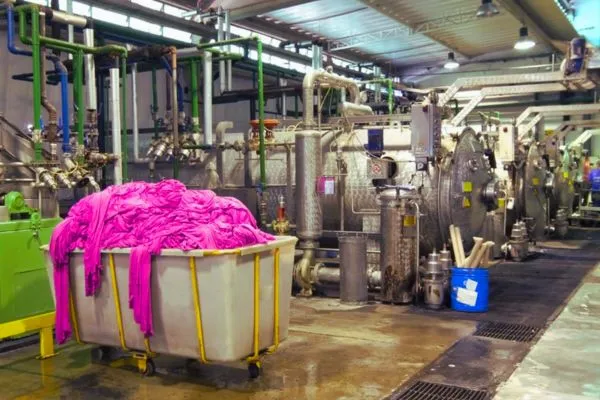Table of Contents
What is the Basic Dye? and What is the Basic Dyeing Process? However, in this article, you will get to learn about basic dyeing processes on different fibers. So, keep reading if you really want to know more about the Basic Dyeing Process and the recipes as well.
Basic Dye:
▪ Basic dye is ionic in nature, when ionizes produces colored cation & colorless anion. The colored portion is prepared from free of subtracted amino groups i.e. -NH2, -N(CH3)2, etc.
▪ The dye bases usually have a general formula that is capable of salt formation.
▪ Base containing no quinonoid chromophore is colorless, color appears on salt formation.

Properties of Basic Dye:
✔ Basic dye is water insoluble but soluble in alcohol and methylated spirit.
✔ Brilliant shade is formed.
✔ Basic dye reacts with strong alkali and produces a Colorless dye base as below:
✔ No affinity to cotton Fiber.
✔ Acrylic Fiber is reacted with Basic dye.
✔ Direct affinity to jute Fiber and easy to dye.
✔ Reduced with reducing agent & produced Colorless dye base, but when re-oxidized by acetic acid, again colored compound easily.
✔ Washing fastness is moderate to poor.
Classification of Basic Dye:
◽ Group-I: Derivatives of Diphenyl amine+-
◽ Group-II: Derivatives of Tri-phenyl methane
◽ Group-III: Derivatives of Thiazine
◽ Group-IV: Derivatives of Oxazine group
◽ Group-V: The Azines
◽ Group-VI: The Xanthene dyes
◽ Group-VII: Basic dyes containing azo groups
◽ Group-VIII: Basic dyes containing Thiazole group
Method of Jute dyeing with Basic dyeing:
Recipe:
Dyestuff: 2%
Acetic acid: 3%
M: L= 1:20
Temp: 80-1000C, Time: 1 hr.
▪ Paste is formed with dyestuff and acetic acid with the addition of water.
▪ Then the sample is kept in a dye bath & treated at 80-1000C temp for 1 hr.
▪ After dying, the dyed sample is squeezed after washing and then drying.
▪ After treatment: To improve luster, treated with 2% Alum at 70-800C for 15-20 min & to increase dye stability, treated with 2% acetic acid for 15-20 min at 70-800C.
Dyeing of Cotton with Basic Dye:
▪ Basic dyes are rarely applied to cotton or cellulose fibers because cellulose has no acidic group and therefore no affinity for basic dyes.
▪ Cotton dyeing with basic dye is performed in 3 steps-
- Mordenting
- Fixing
- Dyeing
▪ Mordenting: Tannic acid used as a mordant, cellulose affinity to basic dye increased.
✔ Recipe: Tannic Acid: 4%
M: L= 1:20
Temp: 100-600C, Time: 2 hrs.
▪ Fixing: Tannic acid becomes fixed up to cellulose.
✔ Recipe: Tartar emetic acid: 2%
M:L Ratio= 1:20
Temp: Room temp, Time: 30 Min.
▪ Dyeing:
✔ Recipe: Basic dye: 2%
Acetic acid: 1-3%
M: L= 1: 20
Temp: up to 700C, Time: 1-1 ½ hrs.
✔ Acetic acid, 1/3 dye solution & mordanted cellulose is kept 15 min at 400C.
✔ Then by adding one-third dye solution, kept 15 min at 300-400C.
✔ At last add the rest amount of the dye solution, and keep 25 min at 700C.
Application of Basic Dye on Protein Fiber/Wool:
Recipe:
Dyestuff: 2 %
Acetic acid: 2%
Salt: 10%
M:L Ratio: 1:30
Temp: up to 900C, Time: 30-40 min.
▪ At first paste is formed by mixing dye & acetic acid & making a solution by adding water.
▪ Additional water & mtl. is taken into a dye bath & dye liquor is added slowly.
▪ Then temp is increased to 900C & salt is added slowly, and kept for 30 min.
Application of Basic Dye on Silk:
Recipe:
Dyestuff: 2%
Acetic acid: 2%
Salt: 10%
M: L= 1:30
Temp: 800C, Time: 30 min.
Dyeing of Acrylic Fiber with Basic Dye:
▪ Recipe:
Dye: 0.4%
Acetic acid: 1.1% (PH: 5-5.5)
Sodium acetate: 0.3%
M: L= 1:30
Temp: 850-1100C, Time: 2 hrs
Difference Between Direct Dye, Acid Dye, and Basic Dye:
| Direct dye | Acid dye | Basic dye |
| 1. Dye molecules contain only one azo group. | 1. They have no direct affinity to cellulosic or protein Fibers. | 1. Forms colored cations & colorless anions in solution. |
| 2. The size of the dye molecule is big. | 2. Small. | 2. Smaller than direct dye. |
| 3. Dyeing medium: any medium. | 3. Acid or neutral medium. | 3. Neutral medium. |
| 4. Forms colored anion & colorless cation in solution. | 4. Forms colored anion & colorless cation in solution. | 4. They have a direct affinity to cellulosic Fibers. |
| 5. They have no direct affinity to cellulosic or protein Fibers. | 5. They have a direct affinity to cellulosic Fibers. | 5. They have no direct affinity to cellulosic or protein Fibers. |
Trade name: Methylene Blue, Methyl violet, Bismark Brown, Megenta etc.
